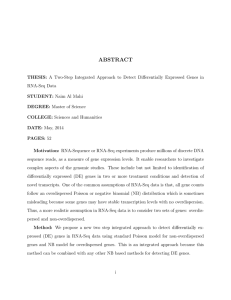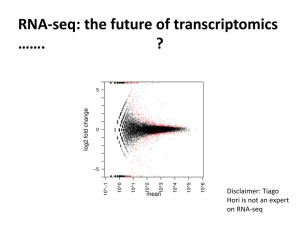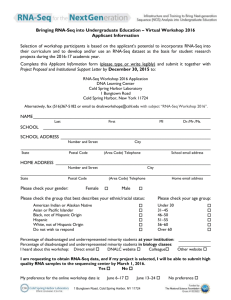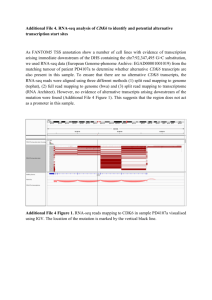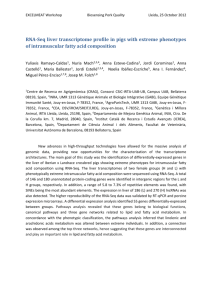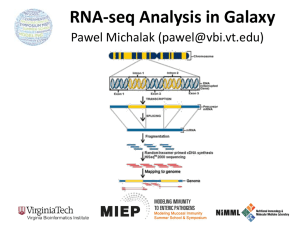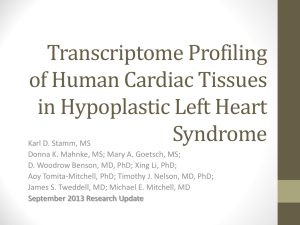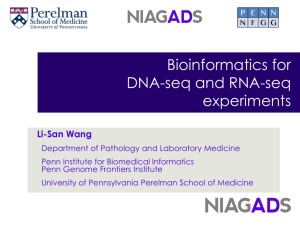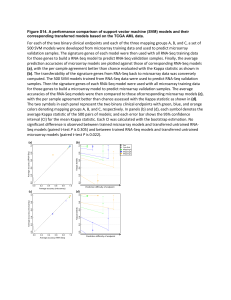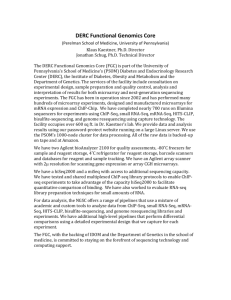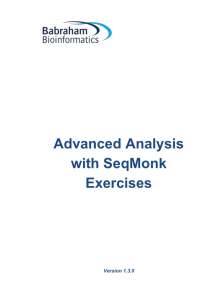RNASeqGUI
advertisement
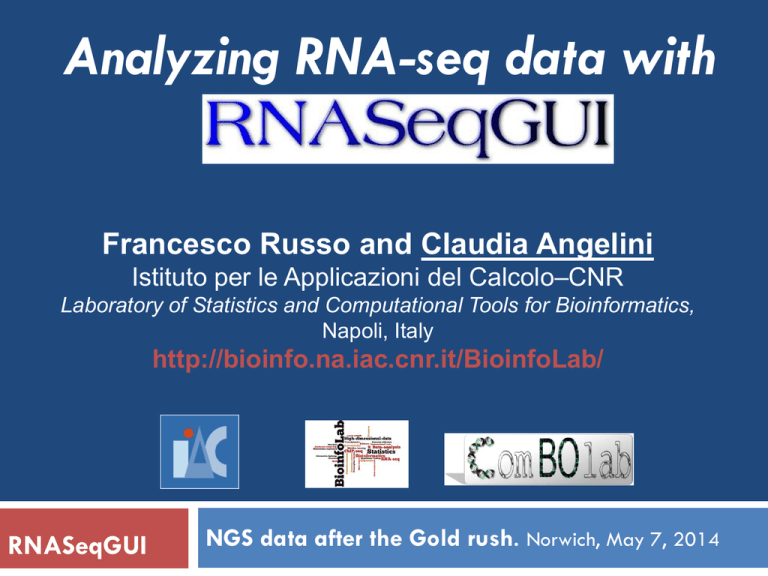
Analyzing RNA-seq data with Francesco Russo and Claudia Angelini Istituto per le Applicazioni del Calcolo–CNR Laboratory of Statistics and Computational Tools for Bioinformatics, Napoli, Italy http://bioinfo.na.iac.cnr.it/BioinfoLab/ RNASeqGUI NGS data after the Gold rush. Norwich, May 7, 2014 Motivations RNA-seq has quickly become one of the preferred and most widely used approaches for whole transcriptome analysis Analyzing RNA-seq data usually requires to carry out several steps, to use different methods and to compare their outputs to obtain more reliable and less biased results. Automatic pipelines are very useful, but they are not interactive, neither are easily customizable by non expert users Many tools are available in the literature most of them require the user to be familiar with command-lines and/or some programming languages R and Bioconductor constitute precious resources in terms of open software tools for RNA-seq data analysis RNASeqGUI RNASeqGUI is a graphical user interface that facilitates RNA-seq data exploration and analysis. More in detail, It is a novel R-package (open-souce) that implements a graphical user interface for the DE analysis of RNA-Seq data. It includes several well known RNA-Seq tools, available at www.bioconductor.org. (RNASeqGUI will be soon available there). In the spirit of reproducible research, it generates a text report of all steps performed during the analysis of a specific project. RNASeqGUI has the following features: High usability, portability, customizability. Moreover, the interface is not just a collection of some known methods, but it is designed to guide the user during the entire analysis process. RNASeqGUI RNASeqGUI is implemented in R. It requires the RGTK2 graphical Library to run It uses BiocParallel to speed up the computations. RNASeqGUI can be downloaded from http://bioinfo.na.iac.cnr.it/RNASeqGUI/ (soon also from Bioconductor) F. Russo and C. Angelini. RNASeqGUI: A GUI for analysing RNA-Seq data, To appear Bioinformatics, (2014) For information about pre-releases or if you require specific functionality, please contact us. RNASeqGUI workflow RNA-Sequencing FastQ File Quality analysis Alignment RNASeqGUI Bam Exploration Available in next release (June 2014) Quantification Differential gene expression Inspecting data and results GO/Pathway Analysis Biological Interpretation RNASeqGUI Main Interface The GUI is divided into several sections. Each section is dedicated to a particular step of the data analysis process. The analysis starts by creating a project or opening an existing project. Then, the user can access any of RNASeqGUI sections. Data Analysis Section is the core of RNASeqGUI and contains several methods to identify differentially expressed genes (DE). Navigating RNASeqGUI By clicking to any specific section a new interface, that contains more specific functions, will open. The “how to use” button in each interface will guide the user in the choice of the best options and parameters. BAM Exploration Section This interface includes five different methods to explore the alignment files (in bam format): Show Read Counts, Mean Quality of the Reads, Quality of Reads, Reads Per Chromosome, Nucleotide Frequencies. This section is important to discover possible errors that may have occurred during the alignment step or during the experimental steps. Count Section This interface gives the possibility to perform the gene quantification process (against an annotation file in GTF format). It works similarly to HTSeq. i.e., it can be used in three different modes (Union, IntersectionStrict and IntersectionNotEmpty) The “counting” process is realized using the R function summarizeOverlaps in the GenomicRanges package that is relatively slow. Current pre-release also includes featureCounts that is much more fast and less computationally demanding Pre-Analysis Section Data exploration It is divided in two panels: Data exploration and Data Normalization Data normalization Plots can be customized in terms of colors/scale/… etc Current normalization methods include RPKM, Upper Quantile, TMM, Full Quantile. Future release will also include those ones from TCC R Package Data Analysis Section The Data analysis interface contains several methods for detecting differentially expressed genes Current release includes EdgeR, DESeq, DESeq2, NOISeq, BaySeq Future release will include also EBSeq; Characteristic Direction DEG, as well as others Tab delimited tables of all genes under investigation and subset of differentially expressed genes are automatically generated Post-Analysis Section Result exploration It is divided in two panels: Result Exploration and Result Comparison Plots can be customized in terms of colors/scale/… etc Result comparison Utility Section It is a novel section devoted to general purpose function. Current pre-release contains functions for combining and for filtering tables Future releases will include also the possibility to incorporate results from Cufflinks (2.2.0). It will be then possible to use functions for exploring and comparing results, including those obtained from Cuffdiff. Adding new functions in RNASeqGUI RNASeqGUI is easily highly customizable It is possible to add a new button to the interface in only 3 steps. RNASeqGUI & Reproducible Research Reporting results and steps of data analyses in a reproducible manner is of fundamental importance, although often neglected in many research paper. The need for RR increases dramatically as data analyses become more complex, involves larger datasets and more sophisticated computations, such as in the case of RNA-seq data analysis GUIs do not easily facilitate RR, since results are obtained after clicking several buttons difficult to keep track of all performed steps To this purpose RNASeqGUI automatically generates a txt report of all analysis carried out on a given Project. The report includes all versions of the R packages used, all steps, input/output parameters, file names and so on. Future releases will make use of R markdown documents for RR Conclusion and Future Work RNASeqGUI is graphical user interface (GUI) for the identification of DE genes across multiple biological conditions It mainly devoted to user that have limited experience with command-line software It is designed to work with standard PCs or small workstations – to the analysis of small/moderate scale projects It is also helpful for those who are expert R-users, since it speeds up the usage of the included RNASeq methods drastically. It is very easy to add new functions For each project it provides automatically the text report of all actions performed on the dataset (in the spirit of RR) Future versions of RNASeqGUI will include new methods for DE new normalization procedures Complex experimental designs Pathway analysis Gene Ontology. Preliminary version available also for based on Shiny (do not require GTK2) http://www.rstudio.com/shiny/ ACKNOWLEDGEMENTS Thanks to all members of Francesco Russo, PhD The main RNASeqGUI developer Supporting Projects For useful discussions, debugging and suggestions THANK YOU FOR THE ATTENTION Questions?
